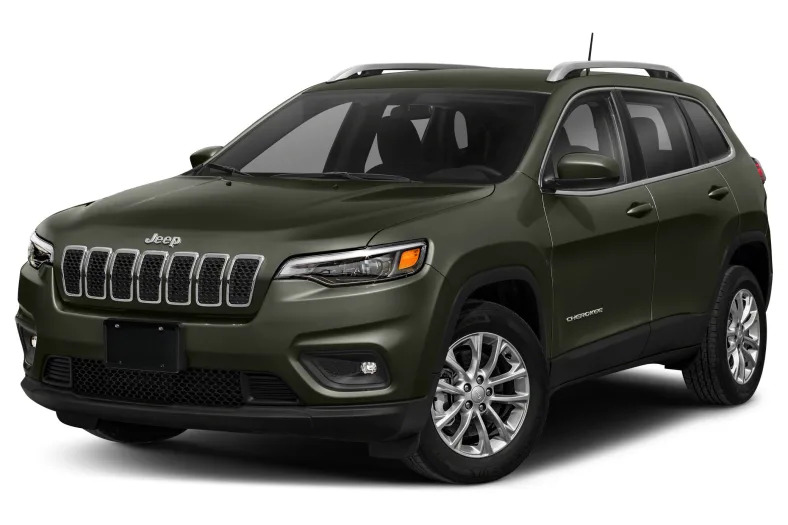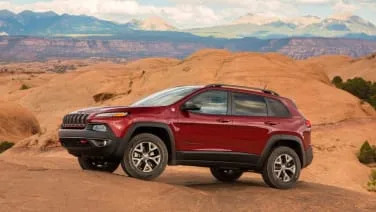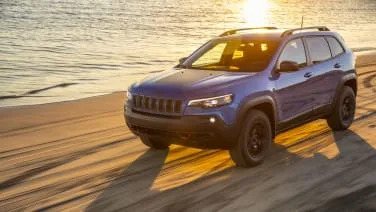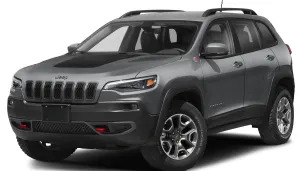Overland 4dr 4x4
2019 Jeep Cherokee
Dormant until its 2014 revival, Cherokee is a name that has a special place in Jeep history as the vehicle that essentially launched the sport-utility boom back in 1974. Prior to the Cherokee most SUVs were either Jeeps (CJ5, CJ7) or rugged wagons designed to perform in unpaved terrain (think Ford Bronco). The original Cherokee was a game-changer. Cherokees began showing up in suburban driveways and supermarket parking lots, owned or at least driven by women. The phenomenon did not go unnoticed by the rest of the industry. Chevrolet soon responded with the Blazer II, Ford with the Bronco II, and it was game on.
For 2019, the latter day Cherokee gets an extensive refurbishing. Though the updates don't extend to the basic architecture (chassis dimensions carry over from the 2014 revival) the exterior has been restyled, the interior is a little more upscale, cargo capacity makes an incremental gain, the engineers have pared as much as 150 pounds from curb weights (depending on model), there's a new turbocharged four-cylinder engine option, and a new turbodiesel on the horizon.
Basics: like every Jeep but the Wrangler, the Cherokee is a unitbody (the frame and body are unitized), basically a front-wheel drive design with the option of four-wheel drive. It competes with compact crossovers such as the Honda CR-V and Ford Escape.
And of course as with any Jeep, off-road competence is part of the deal, particularly in the Trailhawk model.
The standard engine continues to be a 2.4-liter SOHC four-cylinder, 180 horsepower, 170 pound-feet of torque, and the traditional upgrade continues to be the equally familiar 3.2-liter V6 (271 hp, 239 lb-ft). Shared with the new Jeep Wrangler, a turbocharged 2.0-liter four (270 hp, 295 lb-ft) also joins the option list. All three engines are paired with a nine-speed automatic transmission, and two levels of four-wheel drive are available.
Despite the turbo's big edge in torque, the V6 is the towing champ, rated up to 4500 pounds. The turbo maxes out at 4000 pounds.
All three engines have stop/start technology. The 2.4-liter four and 3.2-liter V6 run on regular fuel, while the new turbocharged 2.0-liter requires premium.
EPA fuel economy ratings for the 2019 Cherokee: 23/31 mpg City/Highway, or 26 mpg Combined with the turbocharged 2.0-liter engine and front-wheel drive, 21/29/24 mpg with all-wheel drive; 22/31/25 mpg for the 2.4-liter automatic, 21/29/24 with all-wheel drive. The 3.2-liter V6 rates 20/29/23 mpg. A Trailhawk 4WD V6 is rated 18/24/21. The turbocharged engine requires Premium gasoline. The 2.4-liter engine can use less-expensive Regular. Splitting the difference, the V6 likes at least Midgrade.
Full Review
Full Review
The original Cherokee was a game-changer. Cherokees began showing up in suburban driveways and supermarket parking lots, owned or at least driven by women. The phenomenon did not go unnoticed by the rest of the industry. Chevrolet soon responded with the Blazer II, Ford with the Bronco II, and it was game on.
For 2019, the latter day Cherokee gets an extensive refurbishing. Though the updates don't extend to the basic architecture (chassis dimensions carry over from the 2014 revival) the exterior has been restyled, the interior is a little more upscale, cargo capacity makes an incremental gain, the engineers have pared as much as 150 pounds from curb weights (depending on model), there's a new turbocharged four-cylinder engine option, and a new turbodiesel on the horizon.
Basics: like every Jeep but the Wrangler, the Cherokee is a unitbody (the frame and body are unitized), basically a front-wheel drive design with the option of four-wheel drive. It competes with compact crossovers such as the Honda CR-V and Ford Escape.
And of course as with any Jeep, off-road competence is part of the deal, particularly in the Trailhawk model.
The standard engine continues to be a 2.4-liter SOHC four-cylinder, 180 horsepower, 170 pound-feet of torque, and the traditional upgrade continues to be the equally familiar 3.2-liter V6 (271 hp, 239 lb-ft). Shared with the new Jeep Wrangler, a turbocharged 2.0-liter four (270 hp, 295 lb-ft) also joins the option list. All three engines are paired with a nine-speed automatic transmission, and two levels of four-wheel drive are available.
Despite the turbo's big edge in torque, the V6 is the towing champ, rated up to 4500 pounds. The turbo maxes out at 4000 pounds.
All three engines have stop/start technology. The 2.4-liter four and 3.2-liter V6 run on regular fuel, while the new turbocharged 2.0-liter requires premium.
EPA fuel economy ratings for the 2019 Cherokee: 23/31 mpg City/Highway, or 26 mpg Combined with the turbocharged 2.0-liter engine and front-wheel drive, 21/29/24 mpg with all-wheel drive; 22/31/25 mpg for the 2.4-liter automatic, 21/29/24 with all-wheel drive. The 3.2-liter V6 rates 20/29/23 mpg. A Trailhawk 4WD V6 is rated 18/24/21. The turbocharged engine requires Premium gasoline. The 2.4-liter engine can use less-expensive Regular. Splitting the difference, the V6 likes at least Midgrade.
Hide Full Review
Retail Price
| Engine | 3.2L V-6 |
| MPG | 19 City / 27 Hwy |
| Seating | 5 Passengers |
| Transmission | 9-spd w/OD |
| Power | 271 @ 6500 rpm |
| Drivetrain | four-wheel |






